The canyon reach of Argentina’s Malleo River is hallowed water — it’s no less impressive than the Henry’s Fork, the Madison or the Frying Pan. Truth be told, it might fish better than any I just mentioned, and it feels every bit as trouty as any trophy river in the States.
It’s also a river with many personalities. Afternoon caddis hatches fade when the sun slides behind the cliffs, and then it’s streamer time. A windy day? Drop a Perdigon under a Chernobyl and stand back. It can also be surprisingly technical and require a deft touch with dry flies and pinpoint placement of long cross-river casts followed by mends that most of us never have to make.
But it is a trout river, through and through. And the rules, while maybe adjusted a bit here and there, are still fairly applicable.
As Nico, who works for Patagonia River Guides based in San Martin de los Andes, slowly cruised the gravel road that mirrors the green waters of the Malleo some distance below us in the canyon, he was quick on the brake, and spent a lot of time looking. Finally, after driving past a few runs that didn’t appeal to him, he pulled the truck into a turnout.
“We’re here,” he said calmly. It was our first day on the water in Patagonia, and both Chad and I were itching to cast. December back home in either icy Idaho or blustery Philadelphia is a far sight from December in the Andean foothills — we were gloriously alone in the sun-splashed canyon, our faces and bare arms hopelessly white. We both looked through the passenger windows of the truck, trying to figure out what spurred Nico to pull over and announce our destination. The sunscreen came out. Fly rods appeared. And then we saw what Nico had seen.
There, about a hundred feet down, the river pushed against the canyon wall, backing up the flow and crafting a sweet little eddy, complete with a foam line and what appeared from the rim of the canyon to be a prolific little caddis hatch.
And then we saw the fish.
Circulating through the flow like schoolkids in a cafeteria line, a host of fat rainbows were busy plucking caddis that managed to get trapped in the surface film. The sheer number of bugs offered easy pickings to the trout, which seemed to average about 17 inches or so, and also seemed to be completely unbothered by a bright, sunny day or the fact that a handful of anglers were about to descend upon them.
Nico led me down what amounted to a glorified goat trail — it was tough walking for a guy still reeling from a reconstructed back and the loss of balance that has accompanied it, unfortunately, but it was doable. We snuck around rocks, slid through little slots in the topography and finally planted our boots at river level.
“OK,” Nico said. “Go ahead.”
Not 20 feet ahead of me, trout rose nonchalantly to bugs stuck in the film, and, after months of refrain, I stripped off the requisite amount of fly line from my reel and made my first cast. Before I’d even stretched a line over the water, I knew something was amiss.
“Wait,” Nico said, holding his hand out toward me. “They see you.”
Indeed. The fish didn’t really spook, per se, but they did sort of sink a little deeper, as could be expected in fairly clear water where overhead predators are likely common. We held tight for a bit and then Nico lowered his hand. Then he dropped to his knees and motioned for me to do the same.
Truthfully, with the little overland jaunt to the water behind me, my back was already fatigued — put me on a running track or a sidewalk, and I’m just fine. Uneven footing? For some reason, that really takes it out of me — it’s my new normal as I work to regain strength after going under the knife. Dropping to my knees was a welcome reprieve.
A few moments after we knelt, I noticed the fish coming back to the pool ahead of us. Then a splashy rise. Then a full-on nose from a hefty rainbow broke the surface, and dinner had resumed.
“OK,” Nico said. “Cast from your knees.”
Following his instructions, I placed a size 14 Elk-hair Caddis tight against the foam line and watched as a rainbow slowly rose from the green depths of the river. In no particular hurry, the trout inhaled the fly on the dead drift, and the trip to Patgonia was off to a raucous start. I caught two more cookie-cutter 17-inch fish before I remembered that I had a buddy, who also likely hadn’t fished in months, standing atop a rock outcropping above me.
I reeled up and motioned for Chad.
“Cast from your knees,” I said as we passed each other on the trail. He nodded.
Generally speaking, a lower profile is preferable in just about any fly-fishing discipline, from the glassy flats of the Caribbean to the snowmelt trickles of the Rockies. And, for a guy like me who stands pretty tall at 6-foot, 5 inches, I’ve become accustomed to casting from my knees, or an even less-dignified position, like I did a few days later on Rio Chimehuin, where I leaned into the streamside rocks and cast to big trout from the comfort of my sizeable butt.
But, even in trout-rich Patagonia, it pays to relearn lessons that are generally universal. Making your profile as small as possible improves your chances with fish that might frequently deal with predators that soar overhead.
Even here, on my local cutthroat streams where the trout are anything but sophisticated, finding a place to kneel and cast can really improve your chances. On rivers with finicky trout, getting smaller is almost always a good idea.
If you can find a spot to kneel, do it, even if you’re midstream. It’s a simple lesson, and one worth relearning — again and again.






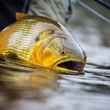




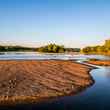
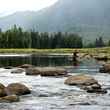




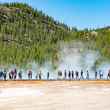



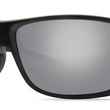




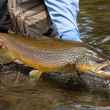
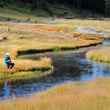

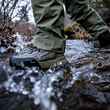


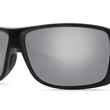
Comments
Steve Z replied on Permalink
Especially when small stream fishing I keep a low profile, wear a camo shirt and buff. Anything to break up my profile and be invisible until the cast. Can't help it that rod makers make the damn things so shiny. When folks ask me what the secret is to fishing small brooks and streams my answer is: "Dirty knees"
Pages